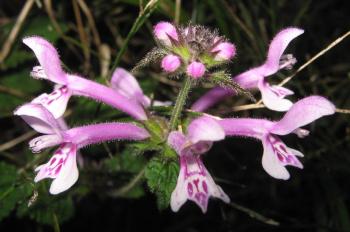Stachys tubulosa
Stachys tubulosa MacOwan
Family: Lamiaceae
Common names: mauve sage, mauve stachys
Introduction
Best grown in shady conditions, Stachys tubulosa is an attractive, evergreen and hardy plant that displays its tubular mauve flowers during the summer season.

Description
Description
This is a soft, straggling, herbaceous perennial that grows 100–400 mm high. It has sparsely branched stems that are hairy throughout. The leaves are pale green, softly hairy, opposite and broadly ovate, 35–70 × 25–65 mm, with a crenate margin.The flowers are pink, flecked with mauve, with a 12 mm long, straight tube and two lobes; the upper lip is ascending, 7 mm long and the lower lip deflexed and pointed, 5 mm long. They appear in clusters of 4–6, in short terminal inflorescences in summer, from November to April.
This plant is closely related to Stachys graciliflora from which it is distinguished by its longer corolla tube.

Conservation Status
Status
This plant is assessed as Least Concern (LC), according to the Red List of South African plants.
Distribution and habitat
Distribution description
Stachys tubulosa is found at 420–1 830 m altitude, in moist, shady forest and forest margins in Swaziland, KwaZulu-Natal and Eastern Cape.

Derivation of name and historical aspects
History
Stachys was named by Linnaeus in Species plantarum, in 1753. The name is derived from the Greek word stachys, meaning ‘an ear of grain or corn’ and refers to the inflorescence that is often a spike. Tubulosa means ‘tubular’, ‘cylindrical’ or ‘pipe-like’, referring to the shape of the flower.
Stachys is a large genus of about 300 species found in subtropical and temperate regions of the world, with 42 species in southern Africa. Plants in this genus have different common names, including hedge-nettle, woundwort, self-heal, betony and lamb’s ears, and it contains many medicinal herbs, such as wood betony (S. officinalis), and ornamentals, for example, Chinese artichoke (S. affinis) and lamb’s ear (S. byzantina).
Ecology
Ecology
Most species in the Lamiaceae family have small flowers that are pollinated by butterflies or bees. The long tubes of the flowers of Stachys tubulosa, are probably pollinated by a long-tongued fly.
Uses
Use
There are no records of Stachys tubulosa being used in traditional medicine. The genus Stachys species earned the name woundwort from the past use of certain species in herbal medicine for the treatment of wounds. In southern Africa some species are used in traditional medicine in the form of a tea.
Growing Stachys tubulosa
Grow
Propagate Stachys tubulosa by stem and tip cuttings to get the best results. Take cuttings from new growth near the base of the plant in spring or early summer and apply a suitable rooting hormone, and they will root very easily. The newly rooted plants respond well to regular feeding with an organic fertilizer.
This plant prefers shade and makes an attractive groundcover. It looks good planted en masse to create a pretty display when in flower. It needs well-drained and composted soil and mulch applied regularly. At Kirstenbosch National Botanical Garden, Stachys tubulosa is used as a perennial for summer colour in shady areas of the garden and under trees. As with many herbaceous perennials, plants must be cut back after flowering as they can become untidy.
References
- Codd, L.E.W. 1985. Flora of southern Africa, 28:1-29, 38-239 accessed via POSA http://posa.sanbi.org 9 May 2016.
- Foden, W. & Potter, L. 2005. Stachys tubulosa MacOwan. National Assessment: Red List of South African plants version 2015.1. Accessed on 2016/05/09.
- Pooley, E. 1998. A field guide to wild flowers Kwazulu-Natal and the eastern region. Natal Flora Publications Trust, Durban.
- Potgieter, C.J. & Edwards, T. 2001. The occurrence of long, narrow corolla tubes in southern African Lamiaceae. Systematics and Geography of Plants 71: 493–502.
- Stearn, W.T. 1992. Stearn’s Dictionary of Plant Names for gardeners. A handbook on the origin and meaning of the botanical names of some cultivated plants. Cassell, UK.
- iSpot southern Africa: http://www.ispotnature.org/species-dictionaries/sanbi/Stachys%20tubulosa?nav=search accessed 9 May 2016.
- Wikipedia: https://en.wikipedia.org/wiki/Stachys accessed 9 May 2016.
Credits
Sisanda Velembo
Kirstenbosch National Botanical Garden
May 2016
Plant Attributes:
Plant Type: Ground Cover, Perennial, Scrambler
SA Distribution: Eastern Cape, KwaZulu-Natal
Soil type: Sandy, Loam
Flowering season: Early Summer, Late Summer
PH: Acid
Flower colour: White, Pink, Mauve/Lilac
Aspect: Shade, Morning Sun (Semi Shade), Afternoon Sun (Semi Shade)
Gardening skill: Average
Special Features:
Horticultural zones









Rate this article
Article well written and informative
Rate this plant
Is this an interesting plant?
Login to add your Comment
Back to topNot registered yet? Click here to register.